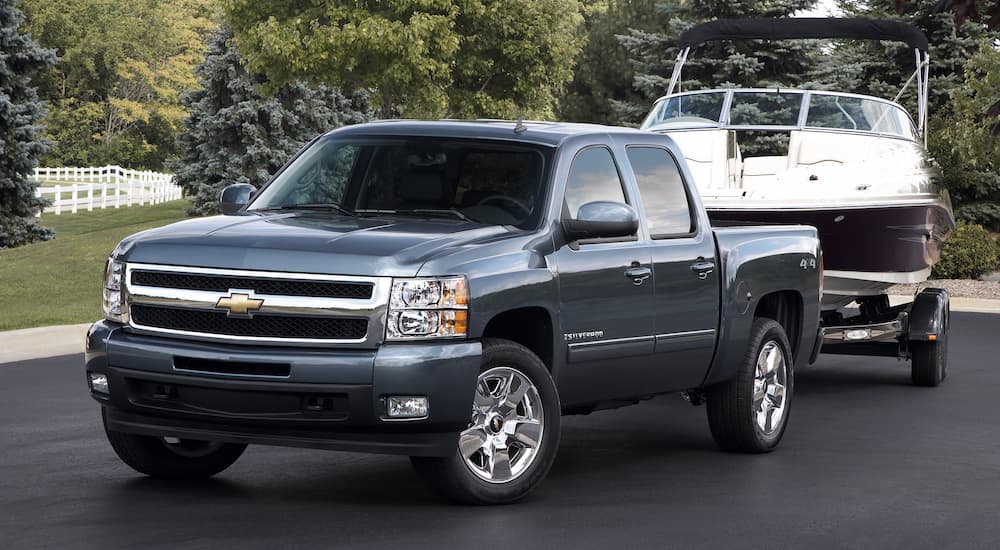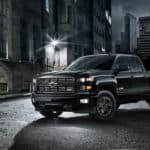Alternative fuel trucks have become a big talking point among the major auto manufacturers within the last five years. It seems like every major truck brand has either a hybrid or electric truck coming to the market. But what if you’re shopping for a truck that’s a bit more traditional? Does it mean you have to stick with only buying a used Chevy Silverado for sale because all the new model year units are alternative fuel variations? Of course not.
It means you have choices, and that’s a worthwhile topic to discuss for prospective truck shoppers, especially those eyeing a Chevy truck. Now that a potential Silverado PHEV could be hitting the market soon, it might be beneficial for your shopping preferences to look at what some of the previous and current powertrains have been and what they currently are for the Chevy Silverado, and how it could impact how you shop for your next truck.
What Could Be on the Horizon for Chevy Silverado
There are already rumors that the next iteration of the Chevy Silverado could see a PHEV (plug-in hybrid electric vehicle) model made available in between the current gas-powered iterations of the Silverado and the new Silverado 1500 EV. The PHEV iterations would basically be Chevy’s answer to Ford’s PowerBoost or the Ram 1500’s Ramcharger. It would bridge the gap for those curious about an alternative fuel truck but not willing to take the full leap to an electric truck.
So, what would the power plant be inside of the Chevy Silverado 1500 PHEV? Those details have yet to emerge. All we can do is keep our eyes peeled for what GM rolls out for the new Silverado when it comes to an alternative fuel powertrain. But how does that affect your current shopping preferences? Well, it definitely changes what could be available for future model years, and it is quite the departure from Silverado’s typical lineup of powertrains.

Chevy’s Early-Gen Silverado Powertrains
During the first generation of the Silverado’s debut as a 1999 model year outing, the powertrain line-up was quite interesting, as it was based on the GMT800 platform and available in rear-wheel or four-wheel drive. It was an important step in a different direction for Chevy in terms of attempting to redefine the production truck segment while competing with Ford and the Dodge Ram at the time. The light-duty 1500 series was available with three different variations of a V8 and a single V6 option. The Silverado HD series had two different V8 options. All of the engine variations were of the Vortec designation.
The first gen V8 was available as a 4.8-liter producing 255 hp at 285 lb-ft of torque while being mated to a 4-speed automatic transmission. A 5.3-liter engine produced 270hp at 315 lb-ft of torque. The 4.3-liter V6 made 200 hp at 260 lb-ft of torque and was paired up with a 4-speed manual transmission. For the HD models, there was the 4.8-liter V8 that produced 255 hp at 285 lb-ft of torque and a 6.0-liter V8 that produced 300 hp at 355 lb-ft of torque.
The second generation – built on the succeeding GMT900 platform – saw the company sticking with the Vortec line-up of engines. This included a slightly less powerful entry-level V6 for the base trim, producing only 195 hp at 260 lb-ft of torque. A Vortec 4.8-liter V8 provided 295 hp at 305 lb-ft of torque, a mixed bag of better horsepower at the expense of lower torque.
The Silverado HD series, however, came with two different Vortec options and a Duramax. There was a 6.0-liter V8 that made between 353hp and 365hp at 373 lb-ft of torque, and a Vortec big block 8.1-liter V8 for the Silverado Classic HD trims that was rated at up to 340 hp at 455 lb-ft of torque. The 6.6-liter Duramax turbo-diesel produced 365 hp at 660 lb-ft of torque, while being paired with an optional automatic or manual Allison six-speed transmission.
The First Attempts at a Hybrid Silverado
Between the second and third generation, GM decided to get a little frisky with the Chevy brand by branching out with a different set of powertrain options in addition to the basic line-up that would be headlined by the EcoTec engines. The hybrid designs between the second and third generations weren’t like the kind Chevy briefly flirted with for the 2005 and 2007 model years, using an electric flywheel generator to power the in-cabin electronics.
The 2009 Chevy Silverado Hybrid was a lot more robust than the 2005 model year outing, pairing two 60 kW electric motors with a 300-volt battery pack and a 6.0-liter V8, all of which made a combined 332 hp at 367 lb-ft of torque. The 2009 Silverado Hybrid was only available in limited quantities, so if you were thinking about shopping for a used Silverado hybrid for sale, your options are quite limited, and you’ll be giving up a lot of newer-gen tech for an older model hybrid.
Finding Stability With the Silverado’s Current Line-Up
The third generation’s introduction of the EcoTec set the stage for the current generation powertrain line-up of the Silverado, including various types of V8 engines, some of which are still being used for production models today. The third-gen Silverado 1500 started with an EcoTec 4.3-liter V6 that made 285 hp at 305 lb-ft of torque, followed by a 5.3-liter V8 that made (and still makes) 355 hp at 383 lb-ft of torque. Then there is the 6.2-liter V8 that makes 420 hp at 460 lb-ft of torque. Both the V8s can still be found in the current Silverado 1500 models with the same specs.
Towards the end of the third generation, GM introduced the inline 6-cylinder Duramax turbo-diesel for the light-duty Silverado 1500 for the 2019 model year, featuring 277 hp at 460 lb-ft of torque. The third-generation Silverado 1500 was also paired up with either a six-speed automatic transmission or an eight-speed automatic transmission. The heavy-duty series of the Silverado found itself in three different powertrain configurations, including a Vortec 6.0-liter V8 at 360 hp and 385 lb-ft of torque.
From the 2020 model year onward, the Silverado HD replaced the Vortec with a 6.6-liter V8 that makes 401 hp st 464 lb-ft of torque. There was also the 6.6-liter Duramax that was rated between 397 hp during the early part of the third generation and 445 hp toward the end of the generation. The Duramax also made and continues to make up to 910 lb-ft of torque and was paired up with an Allison six-speed automatic transmission during the third generation and an Allison 10-speed transmission during the fourth generation.
The mid-cycle refresh of the third-generation also saw an eAssist feature being added to the Silverado 1500 for the 2016 model year, which would be known as the Automatic Engine Start/Stop feature to reduce emissions and fuel consumption. This would become standard for future Silverado models, usually abbreviated as ESS (Engine Start/Stop). The dynamic fuel management system was also available for fourth-generation models, starting with the 2019 Silverado model, which would shut off cylinders depending on active use to conserve fuel.
The fourth generation stayed largely the same based on the third generation developments. However, the EcoTec V6 would be phased out after the 2022 model year. The fourth-gen also introduced a 2.7-liter 4-cylinder that offered 310 hp at 348 lb-ft of torque. The 4-cylinder would later be re-tuned as a high-output turbocharged engine and then renamed TurboMax. Since the 2022 model year, the TurboMax is capable of outputting up to 310 hp at 430 lb-ft of torque. The 3.0-liter Duramax also stayed part of the line-up, producing up to 305 hp at 495 lb-ft of torque from the 2023 model year. There’s also the two V8 options, which have retained their specs since the third generation but are now mated to a 10-speed automatic transmission.

Hybrid Vs Gas Vs Diesel Fuel Economy
When it comes to shopping for a used Chevy Silverado, the right truck and engine configuration make all the difference in the world. If you’re all about fuel economy, you might be lured toward the 2009 Silverado Hybrid because it gets 21 MPG in the city and 22 MPG on the highway in rear-wheel drive. Those are definitely better than most figures associated with the V6 and V8 options of older Silverado 1500 models. But when you compare that to the fourth generation Silverado 1500, you get similar fuel economy out of the TurboMax, which gets 18 MPG in the city and 22 MPG on the highway.
You might think the Silverado Hybrid could be the better option, but also consider that in rear-wheel drive, it tops out at 6,100 lbs worth of towing, whereas the TurboMax in rear-wheel drive tops out at 9,500 lbs worth of towing. Additionally, the Duramax still offers the best fuel economy for the Silverado 1500, at 23 MPG in the city and 29 MPG on the highway in rear-wheel drive. Even in four-wheel drive, the Duramax tops out at 23 MPG in the city and 27 MPG on the highway. And best yet, the Duramax still enables you to tow up to 13,300 lbs, which is more than twice the towing capacity of the Silverado Hybrid.
Shopping Smart for a Chevy Silverado That Appeals to You
If a PHEV version of the Silverado seems appealing, you can always wait to see what it looks like before committing to any serious shopping preferences. However, if you want certain kinds of performance out of the Silverado and you’re more so looking for something functional and reliable, most people shopping for a used Chevy Silverado for sale look to the third or fourth-generation models. They’re new enough to come equipped with a lot of newer tech, infotainment, and safety, but they are old enough to be a lot more affordable than buying new.
The biggest difference between the third-gen and fourth-gen, besides looks, is the Duramax specs and the TurboMax. The TurboMax is a better-tuned powertrain overall than the Vortec or EcoTec V6 entry-level variations; it has better torque and trailering capacity. If you’re more into the V8 variety, you can’t go wrong with either generation of a used Silverado, and that’s good news for those of you shopping specifically for a V8, especially if you’re eyeing something older but still want something powerful.
Hopefully, this helps you better understand what the different generations of the Silverado powertrains have to offer when it comes to what you’re shopping for, how the hybrid technologies fit into the Silverado’s trucking ecosystem, as well as your potential considerations of choosing the right powertrain configuration for the truck you’re looking to buy.



